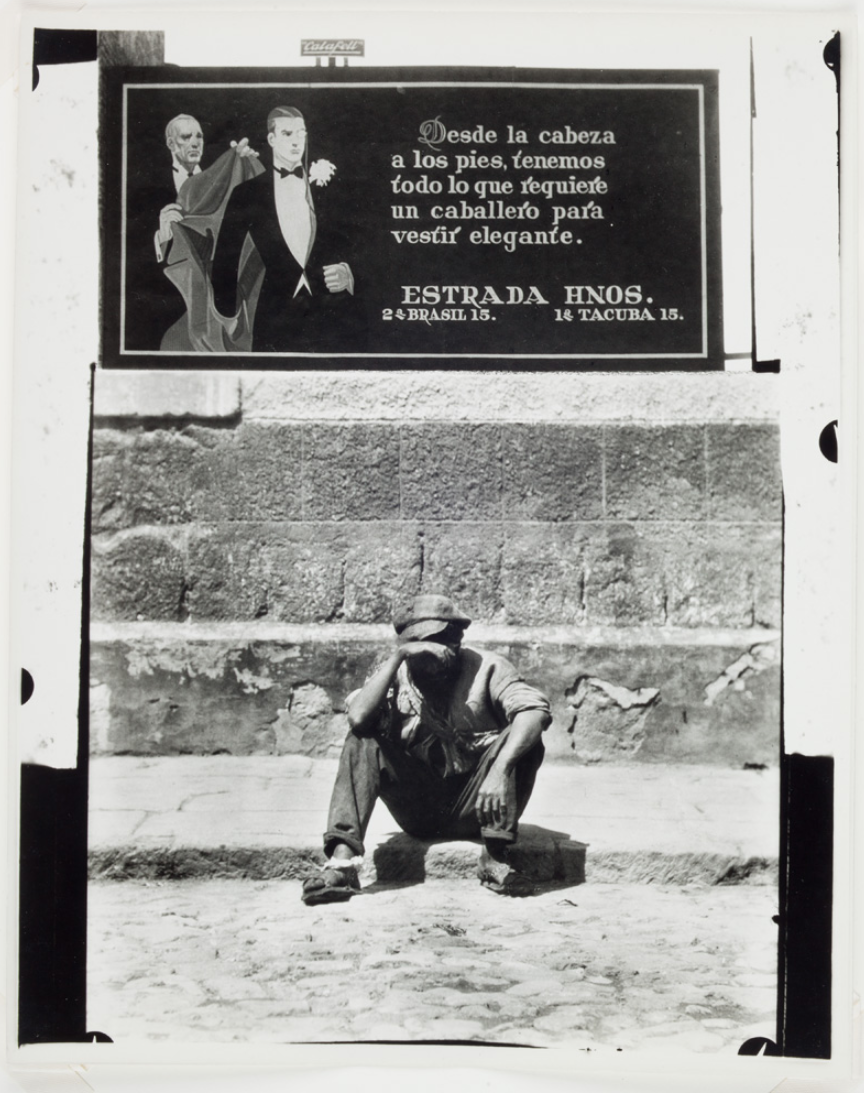
Elegance and Poverty (1928)
*
November 12, 2023
by Philip Gambone
The first time I ever saw a photograph by the the Italian-born Mexican photographer Tina Modotti, I was completely bowled over. I was in the Wellesley College Art Museum, where I had taken myself to explore the museum's collection of pre-Columbian pottery. Afterwards, I wandered through other galleries, including a corridor of twentieth-century photographs from the museum's permanent collection. That's when I came face to face with Elegance and Poverty (1928), one of Modotti's most stunning images.
The gelatin silver print shows an impoverished Mexican worker sitting on a curb, his brow wearily resting in his hand. Above him, a poster shows a well-turned-out caballero being suited up in the latest smart fashions. "From head to toe, we have everything a gentleman needs to dress in style," the advertisement proclaims. The contrast is stark; the message devastatingly direct.
Modotti was not only a consummate photographer, but a daring political activist. Her life was bohemian, creative, defiant, courageous, colorful, tumultuous, and fraught with danger—a subject that attracted another foreign-born Mexican, the writer Elena Poniatowska. In 1992, Poniatowska published Tinísima, her fictionalized biography of Modotti, a woman whose life was, says Latina poet and novelist Ana Castillo, "the stuff of legendary heroines."

Elena Poniatowska
*
Poniatowska has been called "Mexico's grande dame of letters." Born into an aristocratic French family, she came to Mexico at age 10, learning the language of her new country from everyday folk on the streets. At the age of 21, she began her writing career as a journalist.
For almost seven decades, Poniatowska, who is 91, has produced an extraordinary body of work including novels, short stories, essays, journalism, poetry and children's books. She has been "ampliamente premiada"—highly awarded—garnering an impressive number of prizes, including the José Fuentes Mares National Prize for Literature, the Alfaguara Novel Prize, and Mexico's National Journalism Prize, the first woman to do so. According to the jury who in 2013 awarded her Spain's Premio Cervantes Literature Prize, Poniatowska is "one of the most powerful voices in Spanish-language literature these days." Mexican women and the marginalized have been at the forefront of her work. These themes clearly imbue Tinísima, her fictionalized biography of Tina Modotti.
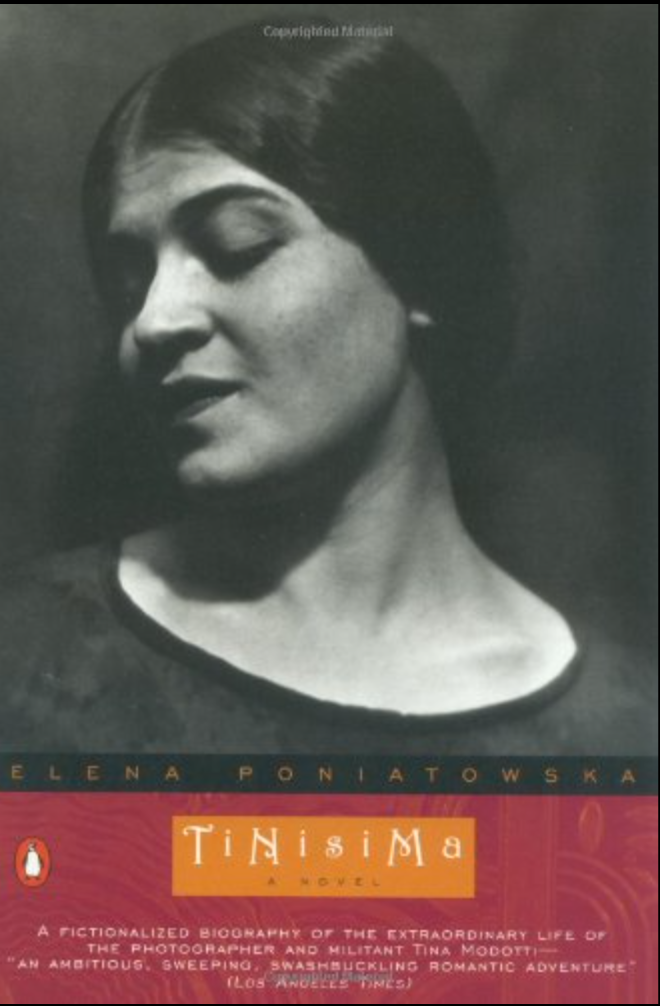
In Tinísima, on which she spent 16 years doing research, Poniatowska weaves together reportage, history, and biography. All of Poniatowska's skills are at work here: professional investigation, concise methods of summarizing history, strong dialogue, vivid scene painting, and a fine writer's instinct for homing in on a marvelous subject. Tinísima won the Mazatlan Literature Prize in 1992. Three years later, the book appeared in English, admirably translated by Katherine Silver.
Tina Modotti was born in Italy in 1896. Her parents were so poor that some nights the family went without even a supper of polenta. At the age of eleven, she began working as a machine operator in a garment factory. In 1913, Modotti immigrated to San Francisco, where her father and sister were already living. She was a beauty. "Men found her compelling," Poniatowska writes, "a woman so in touch with her body. To attract was part of her nature."
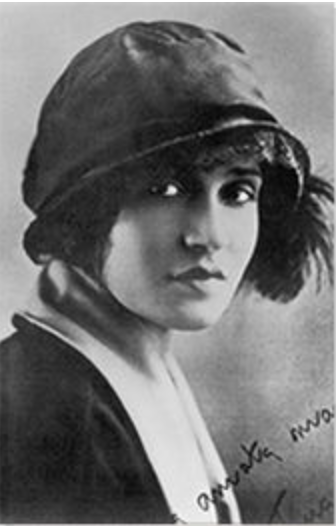
Tina Modotti
*
By 1918, Modotti won the notice of the American poet Roubaix ("Robo") de l'Abrie Richey, with whom she began a romantic relationship. The couple moved to Los Angeles, where they associated with other artists and intellectuals. As "the most attractive woman in Mexico in the twenties," Modotti was hired by Metro-Goldwyn-Mayer and appeared in a number of silent movies, always cast as the harem girl, the villain, the gypsy. She hated the mediocrity of these films. She wanted something better for herself. She "aspired to be a woman of action, an adventuress."
In no time, she caught the eye of another bohemian artist, the photographer Edward Weston, and agreed to be photographed by him. They embarked on a delirious affair. From then on, Modotti "lived in a whirlwind." She and Robo, who was ignorant of her affair with Weston, were encouraged to go to Mexico by her poet friend Ricardo Gómez Rebelo. "The situation in Mexico is perfect for artists," he told them. They were seen as educators and leaders in a Latin American renaissance. "Mexico, with its mixture of blood and gold, would ignite the world."

Edward Weston
*
When Robo suddenly died, Modotti came more and more under the spell of Weston, who showed her the fundamentals of photography but also began "to possess her with the fury of resentment."
Modotti's early photographs were abstract, speaking to the intellect and to the unconscious. They exerted "a power of interiority." As she became more politically aware, she felt more and more drawn to Mexico's other face, "the Mexico of the poor and the hungry who live in shacks no better than dog kennels." "I cannot," she wrote to Weston, "solve the problem of life by losing myself in the problem of art."
She started to move emotionally away from Weston, eschewing the wild parties of their earlier years together. She no longer wanted to waste film shooting roses, lilies and crystal vases "while the streets were exploding with human misery." Instead, she turned her lens on subjects that were "a slap in the face of the bourgeois conscience."
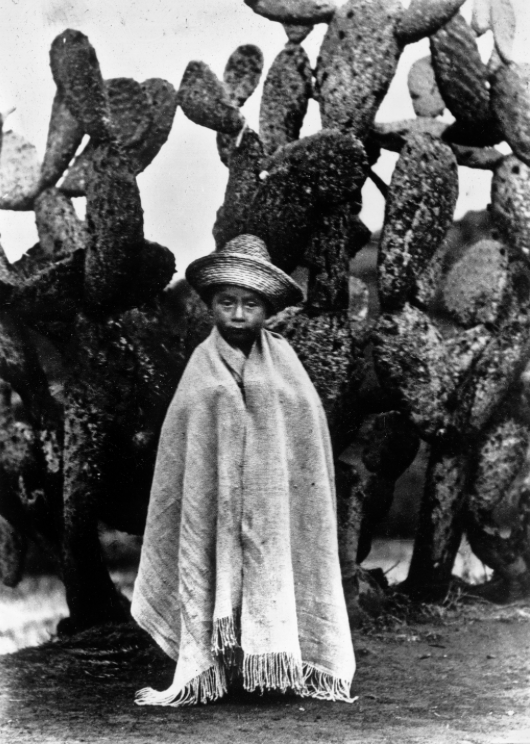
Boy in Front of a Cactus (1929)
*
Modotti began to volunteer at the headquarters of the Mexican Communist Party and document the left-wing murals then being painted by artists like Diego Rivera. In 1927, she became a card-carrying member of the Communist Party. The walls of her studio were plastered with quotations from Lenin. Two years later, she was invited to exhibit her photographs in the National Library of Mexico. The exhibition was attended by hundreds of workers who were moved by her depiction of their plight. The artist David Siqueiros called it the "first revolutionary photographic exhibition in Mexico."
From then on, Modotti devoted herself with ever more fervent resolve to anti-fascist political activity. By 1930, she was in Moscow, where she helped refugees get settled. Addressed as Comrade Modotti, she felt "the golden liquid of belonging, part of a group that will not easily give her up." Poniatowska's depiction of the Moscow of the thirties is excellent: the harshness of the Party elite; the tiny, grim apartment that Modotti lived in with another lover, Vittorio Vidali; the long hours waiting in line to buy a kilo of potatoes; the many acts of self-denial all in the service of the Party.

Hammer, sickle, and sombrero (1927)
*
During the Spanish Civil War, Modotti went to Spain, joining the anti-fascists in their struggle to save the Spanish Republic. She was willing to do anything. When the fascists won, she was left with a sense of profound loss. "She had fought the war from the first day to the last."
With Franco's victory, Modotti returned to Mexico a different woman. She kept her sadness to herself, wanting only to be left alone. She began to grow alarmingly thin. By now, the Nazis were rising to power in Europe. When the Soviet Union signed a non-aggression pact with Hitler, she felt it was a betrayal of everything she and the Spanish Republicans had struggled for. Nothing seemed left for her, this once powerful woman who had "made decisions, devastated suitors, made a way for herself in the world." Her last months were lived in monastic austerity.
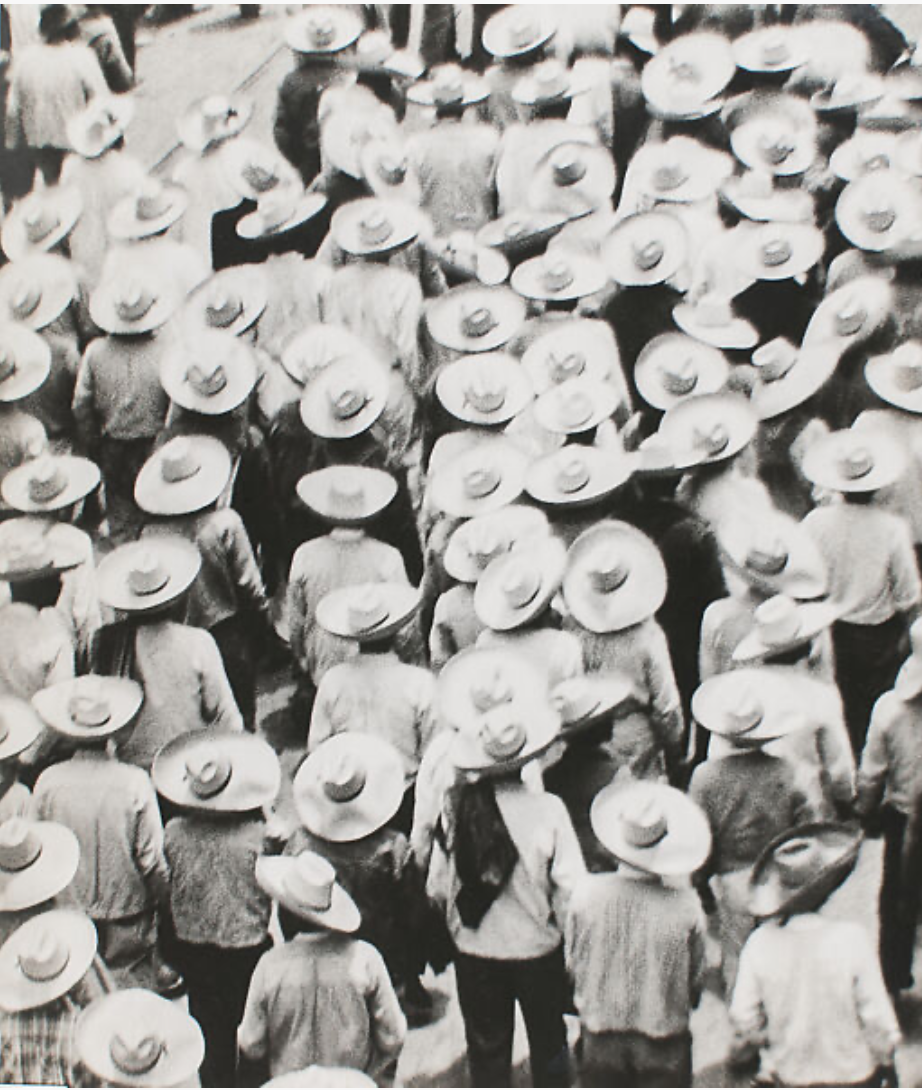
Campesinos (1926)
*
When Modotti died in 1942, the conservative press vilified her, calling her the Mata Hari of the Comintern, "a depraved and dangerous woman." But she was also honored by the struggling workers for she had so tirelessly served. At her funeral, she was called Mexicana ad honorem. "She has every right to be considered part of the history of the Mexican Revolution," one speaker said. "Pure is your sweet name, pure your fragile life," wrote Pablo Neruda in a poem published in all the Mexican newspapers.
Modotti's relationship with Mexico was "something electric," and Poniatowska—a woman who adopted Mexico as her home looking at another woman who adopted Mexico as her home —brings all that electricity to life in this eminently readable book.
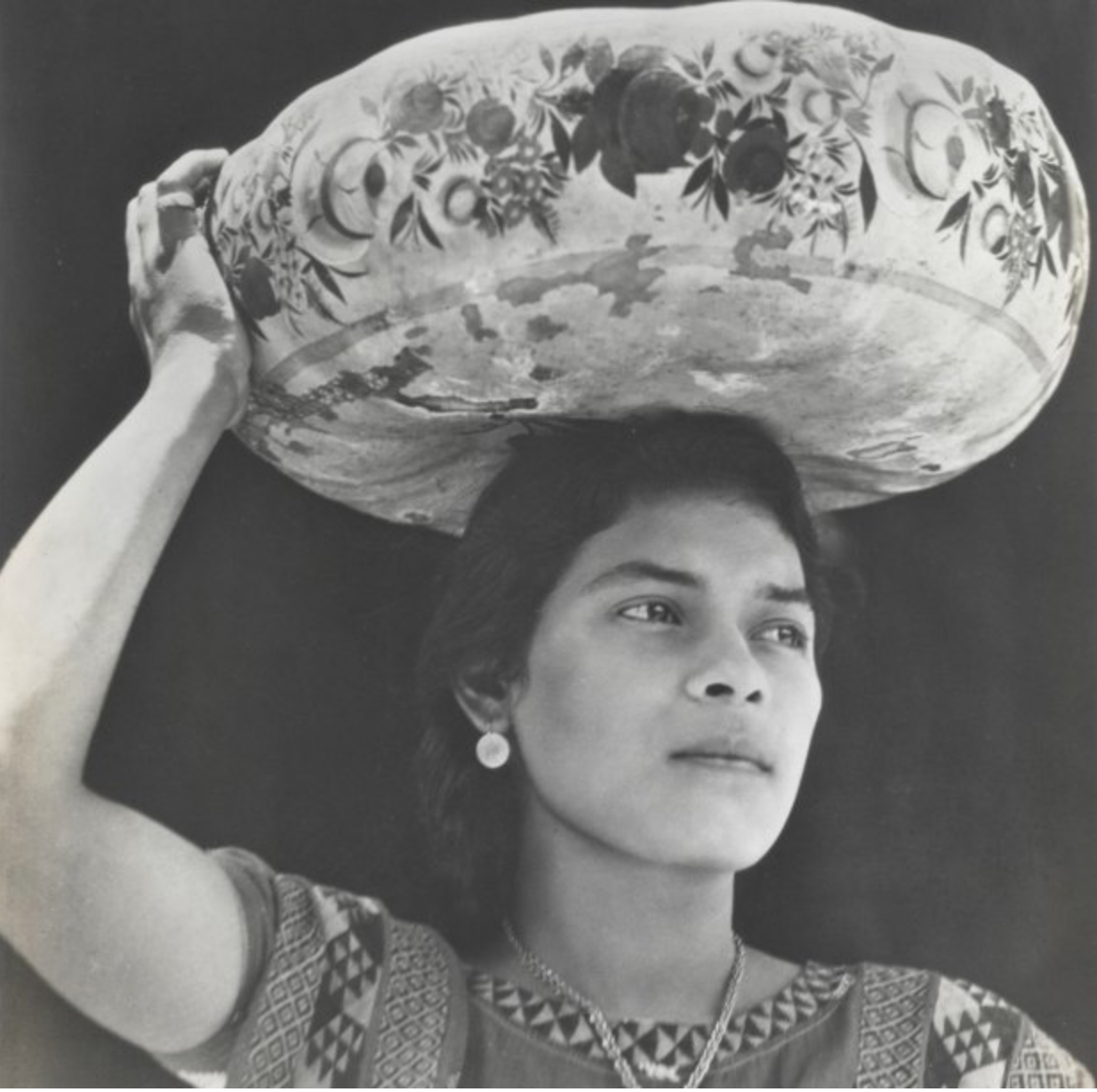
Woman with a painted pumpkin on her head (1929)
*
**************

Philip Gambone, a retired high school English teacher, also taught creative and expository writing at Harvard for twenty-eight years. He is the author of five books, most recently As Far As I Can Tell: Finding My Father in World War II, which was named one of the Best Books of 2020 by the Boston Globe. It is available through Amazon, at the Biblioteca bookshop, and at Aurora Books off the Calzada de la Aurora.
**************
*****
Please contribute to Lokkal,
SMA's online collective:
 ***
***
Discover Lokkal:
Watch the two-minute video below.
Then, just below that, scroll down SMA's Community Wall.
Mission

Visit SMA's Social Network
Contact / Contactar

